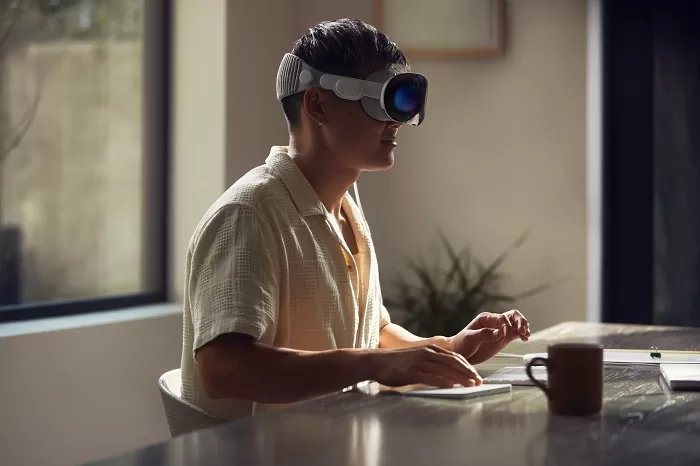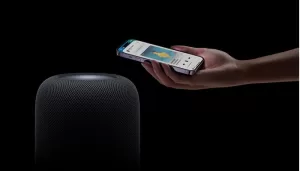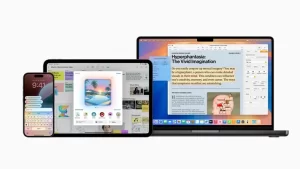Unleashing the Power of AI in Vision Pro

- Apple plans to integrate generative AI into its Vision Pro mixed reality headset and other devices, enhancing user experience and creating new applications in fields such as education and healthcare.
- The AI integration aims to boost the adoption of Vision Pro, despite recent production cuts, by enabling more personalized, immersive experiences and practical business applications.
The Apple Vision Pro mixed reality headset was first announced a year ago today the headset is scheduled for an upgrade to include artificial intelligence.
Apple is set to unveil its first set of intelligent AI applications for the iPhone and iPad this week as part of an overall attempt to inject fresh vitality into its struggling line of products. Even though Vision Pro’s Vision Pro mixed reality headset is just available for sale for just several months, certain experts think that the same technology is likely to soon make it’s way into the devices.
Generative AI, a buzzy kind of artificial intelligence, which is able to give thoughtful and precise responses to queries and prompts that could propel the headset towards a higher degree of personalized and immersive that could lead to brand new applications for companies especially in the medical and education area. The technology could also increase the market for the costly Vision Pro, which has recently received a surprise production reduction.
The every year Worldwide Developers Conference at its Cupertino, California, headquarters beginning on the 10th of June, Tim Cook, the CEO Tim Cook will likely lay the foundation for the company’s future plans with this kind of AI. They’re also planning to work with ChatGPT creator OpenAI to create new levels of interaction within the various product lines. This all comes at an era when the company faces pressure to keep pace with rivals including Google and Samsung who are employing the technology in their phones.
The easy way in
The best way to implement the generative AI in Vision Pro Vision Pro would be through the use of a virtual assistant, as smart as Siri which allows viewers to ask questions regarding the content they’re viewing or automate things like sending text messages through voice commands or turning off the lighting.
Another use case is the ability to translate languages in real time, more collaboration and sharing in the workplace as well as personalized fitness regimens as well as guided meditation as per experts.
However, the experience may become even better for businesses. In its latest earnings conference, the CEO Tim Cook said more than fifty percent of Fortune 100 companies have already purchased the Apple Vision Pro. “ … [We] are exploring innovative ways to use it to do things that weren’t possible before”, before moving on to other topics,” he added.
Tuong Nygugen, a director analyst at market research firm Gartner, said any company which is interested in this market “has to be thinking about it.”
“Nobody really knows what’s a winner yet, so they’re pulling together all these use cases right now, with a focus on enterprise, and making a case for why this is the future of experiences and devices,” he said.
But while it’s unclear when generative AI will come to the Vision Pro, Nygugen said: “It’s only a matter of time.”
That’s because the Vision Pro is merely just another interface – much like a tablet, laptop, or watch, that touches Apple’s ecosystem.
“The leg up isn’t in if Apple uses it – because I would expect everyone to use it – or even if they use it first,” Nygugen said. “It’s about how they use it and how they bring value to the user.”
The future of Vision Pro
The first Apple product to be released since september 2007 hit the market on February 1st, after it was a time when the extended real-time (XR) market — which includes virtual, augmented and mixed reality was at a standstill, with only a small amount of mainstream acceptance by the general public. The headset cost $3,499 and had few apps available out of beginning and comes with batteries that are that is the size of the iPhone and offers 2.5 minutes of battery power in a single battery.
Both businesses and customers generally agreed that the experience for users is unmatched when it comes to consuming immersive video as well as interacting in the universe around us.
Apple is yet to announce specific data about sales on the product, but Apple analyst Ming Chi Kuo has said production would be cut the level of 400 000 units annually, in contrast to the initial industry estimates of 700,000. Incorporating generative AI into the user experience can help designers of any level create captivating content that can draw a larger audience According to Jeremy Bailenson, founding director of Stanford University’s Virtual Human Interaction Lab.
“Although most headsets today are cheaper than smartphones and laptops, there is very limited use by consumers due in part to a lack of compelling content that is designed specifically for headsets like the Vision Pro or the Meta Quest,” he said. “AI will help by allowing people without any programming experience to generate 3D models, immersive scenes, and even avatar bodies and animations.”
In the lab at Stanford, researchers are already using new software which allows a user to describe any scene by speaking out loud, such as “make me a beautiful park in the middle of a big city with cows roaming through it.” The VR results emerge in seconds.
He sees strong use cases around this particularly in education and gaming.
“AI allows teachers to quickly create VR content that fits into their curricula and lesson plans, solving the biggest roadblock of VR in classrooms,” he said. “VR now makes a teacher’s job easier to create lessons, whereas before generative AI, the content creation was so expensive and difficult it often made their jobs harder.”
Generative AI can also transform the way that headsets play games. Social VR, a term used to describe a system that allows users to gather in a group to chat, share ideas and play, tends to be a lonely experience, Bailenson said. While there are plenty of virtual worlds in a typical VR platform, there are less players.
“Generative AI can add non-player characters to make places feel less empty,” he said.
Ramon Llamas, a director at the market research company IDC is convinced that Apple will begin with the commercialization of gen AI using Vision Pro However, its biggest impact will have an impact on the business.
Practical business applications
In one instance, an employee in the field could solve mechanical issues in real-time using the headset as well as the generative AI. The idea is that it can analyze and summarize the collected information, then provide the user with an interactive graph, diagram, or video which shows the user how to fix the issue, he explained.
“This is the bigger play and the magic of generative AI,” he said. “The worker would no longer be looking at a generic video; the tech would go through stacks of files, data, videos and pictures to put something very specific to address the problem.”
Another possible use for the model the model could be used for, said the author, would be to train workers for example, teaching someone to fix the engine of an airplane by using the model as well as additional specifications.
“I think we’ll start to see this more in the next couple of product cycles,” he said. “The race is on to see how quickly we can get generative AI into these devices.”
Meta For instance, Meta has previously expressed the desire to join forces with Microsoft that is firmly integrating its Copilot technology powered by ChatGPT to its own collection of software. Llamas confirmed that a possible collaboration with Meta would enable its Quest headset to make use of Copilot to act as an assistant to help with training. Google could follow the same manner.
Tuong Nygugen, a director analyst at market research firm Gartner, said “anyone who is invested in this market has to be thinking about it.”
“Nobody really knows what’s a winner yet, so they’re pulling together all these use cases right now, with a focus on enterprise, and making a case for why this is the future of experiences and devices,” he said.
However, for the moment most likely, the primary focus will be on getting people used to with generative AI for the gadgets they already use and especially those users hold in their hands.
“Vision Pro just came out a few months ago and it needs to get its feet under it before it really starts to take off,” Llamas said. “With iOS, we already have a base of users and products, so this is probably where Apple will accelerate now.”















